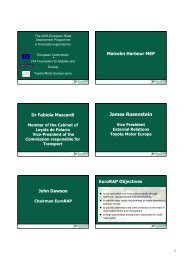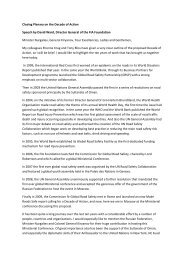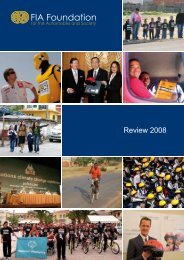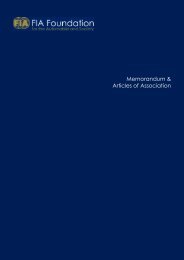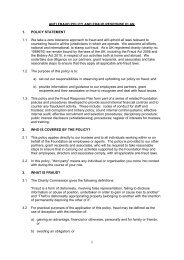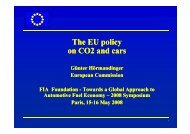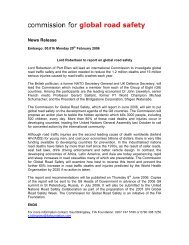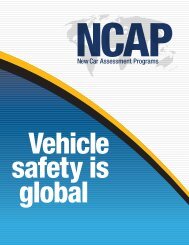Speed management: a road safety manual for decision-makers and
Speed management: a road safety manual for decision-makers and
Speed management: a road safety manual for decision-makers and
- No tags were found...
Create successful ePaper yourself
Turn your PDF publications into a flip-book with our unique Google optimized e-Paper software.
<strong>Speed</strong><br />
<strong>management</strong><br />
A ROAD SAFETY MANUAL<br />
FOR DECISION-MAKERS<br />
AND PRACTITIONERS<br />
good practice
<strong>Speed</strong> <strong>management</strong>: a <strong>road</strong> <strong>safety</strong> <strong>manual</strong> <strong>for</strong> <strong>decision</strong>-<strong>makers</strong> <strong>and</strong> practitioners<br />
ISBN 978-2-940395-04-0<br />
Suggested citation:<br />
<strong>Speed</strong> <strong>management</strong>: a <strong>road</strong> <strong>safety</strong> <strong>manual</strong> <strong>for</strong> <strong>decision</strong>-<strong>makers</strong> <strong>and</strong> practitioners.<br />
Geneva, Global Road Safety Partnership, 2008<br />
© Global Road Safety Partnership 2008.<br />
A hosted programme of the International Federation of Red Cross <strong>and</strong> Red Crescent Societies.<br />
All rights reserved.<br />
Publications of GRSP can be obtained from www.GRSP<strong>road</strong><strong>safety</strong>.org<br />
Permission to reproduce or translate GRSP publications – whether <strong>for</strong> sale or <strong>for</strong> non-commercial<br />
distribution – should be addressed to:<br />
Global Road Safety Partnership<br />
c/o International Federation of Red Cross <strong>and</strong> Red Crescent Societies<br />
PO Box 372<br />
17 Chemin des Crêts<br />
CH-1211 Geneva 19<br />
Switzerl<strong>and</strong><br />
The designations employed <strong>and</strong> the presentation of the material in this publication do not imply the<br />
expression of any opinion whatsoever on the part of the Global Road Safety Partnership, the International<br />
Federation of Red Cross <strong>and</strong> Red Crescent Societies or the World Health Organization<br />
(WHO) concerning the legal status of any country, territory, city or area or of its authorities, or concerning<br />
the delimitation of its frontiers or boundaries. Dotted lines on maps represent approximate<br />
border lines <strong>for</strong> which there may not yet be full agreement.<br />
The mention of specific companies or of certain manufacturers’ products does not imply that they are<br />
endorsed or recommended by the Global Road Safety Partnership, the International Federation of<br />
Red Cross <strong>and</strong> Red Crescent Societies, or WHO in preference to others of a similar nature that are<br />
not mentioned. Errors <strong>and</strong> omissions excepted, the names of proprietary products are distinguished<br />
by initial capital letters.<br />
All reasonable precautions have been taken by the Global Road Safety Partnership, the International<br />
Federation of Red Cross <strong>and</strong> Red Crescent Societies <strong>and</strong> the authors to verify the in<strong>for</strong>mation contained<br />
in this publication. However, the published material is being distributed without warranty of<br />
any kind, either express or implied. The responsibility <strong>for</strong> the interpretation <strong>and</strong> use of the material<br />
lies with the reader. In no event shall the Global Road Safety Partnership, the International Federation<br />
of Red Cross <strong>and</strong> Red Crescent Societies or the authors be liable <strong>for</strong> damages arising from its use.<br />
Design by Inís Communication: www.inis.ie
<strong>Speed</strong> <strong>management</strong>: a <strong>road</strong> <strong>safety</strong> <strong>manual</strong><br />
Table of contents<br />
Acronyms .................................................... vii<br />
Preface ...................................................... ix<br />
Contributors .................................................. xi<br />
Acknowledgements ............................................ xii<br />
Executive summary .............................................xiii<br />
Introduction .................................................. xv<br />
Background to the series of <strong>manual</strong>s ................................ xvii<br />
Background to the speed <strong>management</strong> <strong>manual</strong> . ......................... xix<br />
1. Why focus on speed ..........................................1<br />
1.1 Road traffic crashes <strong>and</strong> injury involving speed ........................3<br />
1.1.1 <strong>Speed</strong>, energy transfer <strong>and</strong> injury .............................3<br />
1.1.2 How does speed affect <strong>road</strong> traffic collisions <strong>and</strong> injury ............6<br />
1.1.3 What factors contribute to speeding .........................10<br />
1.2 What is speed <strong>management</strong> ...................................11<br />
1.2.1 Aims of speed <strong>management</strong> ...............................11<br />
1.2.2 Setting speed limits .....................................13<br />
1.2.3 Safe systems <strong>and</strong> the role of speed ..........................14<br />
1.2.4 Benefits of speed <strong>management</strong> .............................17<br />
Summary .....................................................19<br />
References ....................................................20<br />
2. How to assess the situation ...................................23<br />
2.1 What do you need to know ....................................26<br />
2.1.1 Road functions <strong>and</strong> setting speed limits .......................26<br />
iii
Table of contents<br />
2.1.2 <strong>Speed</strong> <strong>and</strong> crash data ....................................27<br />
2.1.3 Legislation <strong>and</strong> regulation .................................28<br />
2.1.4 <strong>Speed</strong> risk profile <strong>and</strong> vulnerable <strong>road</strong> users ...................30<br />
2.2 How to measure the problem. ...................................31<br />
2.2.1 How big is the speed related injury problem ...................32<br />
2.2.2 How to measure speed ...................................34<br />
2.2.3 <strong>Speed</strong> variance. ........................................39<br />
2.2.4 Assessing community attitudes to speed <strong>management</strong> ............40<br />
2.3 How are speed limits set, communicated <strong>and</strong> en<strong>for</strong>ced ................41<br />
2.3.1 How are speed limits set .................................41<br />
2.3.2 How are speed limits communicated ........................42<br />
2.3.3 How are speed limits en<strong>for</strong>ced .............................42<br />
2.4 Underst<strong>and</strong>ing <strong>management</strong> arrangements .........................43<br />
2.4.1 Who has responsibility <strong>for</strong> the regulation of speed on public <strong>road</strong>s ...43<br />
2.4.2 Who are the <strong>road</strong> <strong>safety</strong> stakeholders. .......................43<br />
2.4.3 What funding is there <strong>for</strong> speed <strong>management</strong> ..................45<br />
Summary .....................................................46<br />
References ....................................................46<br />
3. What are the tools <strong>for</strong> managing speed .........................47<br />
3.1 <strong>Speed</strong> zoning <strong>and</strong> speed limits ..................................50<br />
3.1.1 Classifying <strong>road</strong>s by function <strong>and</strong> activity ......................50<br />
3.1.2 <strong>Speed</strong> zoning <strong>and</strong> speed limit reviews <strong>and</strong> guidelines. .............54<br />
3.1.3 In<strong>for</strong>ming drivers of limits – signs <strong>and</strong> default limit in<strong>for</strong>mation .......59<br />
3.2 Changing behaviour – regulating <strong>and</strong> en<strong>for</strong>cing speed ..................61<br />
3.2.1 Road rules, legislative <strong>and</strong> regulatory settings. ..................61<br />
3.2.2 <strong>Speed</strong> en<strong>for</strong>cement methods ..............................62<br />
3.2.3 Penalties – fines, demerit points <strong>and</strong> licence suspensions ..........66<br />
3.3 Changing behaviour – public education ............................68<br />
3.3.1 Social marketing <strong>and</strong> public education ........................69<br />
3.3.2 Increasing public perception of being detected by police. ...........70<br />
3.3.3 <strong>Speed</strong> compliance incentives. ..............................71<br />
3.3.4 Community-based programmes .............................71<br />
3.3.5 Licensing <strong>and</strong> speed restrictions ............................72<br />
3.4 Engineering treatments .......................................73<br />
3.4.1 Treatments to slow down motor vehicles .......................73<br />
iv
<strong>Speed</strong> <strong>management</strong>: a <strong>road</strong> <strong>safety</strong> <strong>manual</strong><br />
3.4.2 Separation of vulnerable <strong>road</strong> users .........................79<br />
3.5 Use of speed-limiting technology <strong>and</strong> intelligent speed adaptation .........81<br />
3.6 <strong>Speed</strong> <strong>management</strong> by employers ................................84<br />
3.6.1 Legislative measures ....................................85<br />
3.6.2 Education <strong>and</strong> feedback ..................................86<br />
Summary .....................................................87<br />
References ....................................................88<br />
4. How to design <strong>and</strong> implement a speed <strong>management</strong> system. .........91<br />
4.1 Gaining political <strong>and</strong> community support ...........................94<br />
4.1.1 Need <strong>for</strong> providing convincing evidence ........................94<br />
4.1.2 Securing involvement of government leaders. ...................95<br />
4.2 Stakeholders <strong>and</strong> roles. .......................................97<br />
4.2.1 A Working group of government stakeholders ...................98<br />
4.2.2 A reference group of other stakeholders . . . . . . . . . . . . . . . . . . . . . . 101<br />
4.2.3 Sustaining the involvement of stakeholders ...................102<br />
4.3 Preparing a plan of action .....................................103<br />
4.3.1 Setting programme objectives <strong>and</strong> targets ....................104<br />
4.3.2 Deciding on activities ...................................107<br />
4.3.3 Choosing <strong>and</strong> applying tools ..............................111<br />
4.3.4 Making <strong>decision</strong>s about speed limits <strong>and</strong> signs. ................112<br />
4.3.5 Making <strong>decision</strong>s about behavioural change programmes. .........112<br />
4.3.6 Making <strong>decision</strong>s about engineering treatments ................115<br />
4.3.7 Ensuring an appropriate medical response ....................117<br />
4.3.8 Estimating required resources . . . . . . . . . . . . . . . . . . . . . . . . . . . . . 118<br />
4.4 Preparing <strong>for</strong> implementation. ..................................122<br />
4.4.1 Legislative requirements <strong>and</strong> timing .........................122<br />
4.4.2 En<strong>for</strong>cement requirements ...............................122<br />
4.4.3 Revised speed limit signs ................................124<br />
4.4.4 Engineering measures. ..................................124<br />
4.5 In<strong>for</strong>ming, influencing <strong>and</strong> involving the public. ......................125<br />
4.5.1 Working with the media ..................................125<br />
4.5.2 Planning the campaign roll-out .............................126<br />
4.5.3 Carrying out the campaign ................................126<br />
4.6 Planning <strong>and</strong> using pilot projects ................................126<br />
v
Table of contents<br />
4.6.1 What is a pilot project ..................................127<br />
4.6.2 What are the benefits ..................................127<br />
4.6.3 How to plan <strong>and</strong> implement a pilot project. ....................127<br />
Summary ....................................................129<br />
References ...................................................130<br />
5. How to evaluate the programme ...............................131<br />
5.1 Planning the evaluation. ......................................133<br />
5.1.1 Aims of evaluation .....................................134<br />
5.1.2 Types of evaluation .....................................134<br />
5.2 Choosing the evaluation methods ...............................136<br />
5.2.1 Study types <strong>for</strong> <strong>for</strong>mative <strong>and</strong> process evaluation ...............137<br />
5.2.2 Study types <strong>for</strong> impact <strong>and</strong> outcome evaluations ...............138<br />
5.2.3 Conducting an economic evaluation of a programme .............141<br />
5.2.4 Choosing the per<strong>for</strong>mance indicators ........................143<br />
5.3 Dissemination <strong>and</strong> feedback ...................................146<br />
Summary ....................................................147<br />
References ..................................................148<br />
Appendices. .................................................149<br />
Appendix 1: Methods of speed data collection ......................151<br />
Appendix 2: <strong>Speed</strong> en<strong>for</strong>cement – Victoria, Australia .................152<br />
Appendix 3: Examples of suspension or withdrawal of driving licence <strong>and</strong><br />
other non-monetary penalties applied to speed offences ....153<br />
Appendix 4: Traffic calming in Ghana – rumble strips <strong>and</strong> speed ramps ...154<br />
Appendix 5: The International Road Assessment Programme <strong>and</strong> network<br />
<strong>safety</strong> upgrading. ...................................157<br />
Appendix 6: Effective use of police resources .......................163<br />
vi
<strong>Speed</strong> <strong>management</strong>: a <strong>road</strong> <strong>safety</strong> <strong>manual</strong><br />
Acronyms<br />
ABS<br />
Anti-lock braking system<br />
ARRB<br />
Australian Road Research Board<br />
BAC<br />
Blood alcohol concentration<br />
BRRI<br />
Building <strong>and</strong> Road Research Institute (Ghana)<br />
CEA<br />
Cost-effectiveness analysis<br />
CBA<br />
Cost-benefit analysis<br />
DFID<br />
Department <strong>for</strong> International Development (UK government)<br />
ECMT<br />
European Committee of Minsters of Transport<br />
EDR<br />
Electronic data recorder<br />
EMS<br />
Emergency medical services<br />
EU<br />
European Union<br />
FIA<br />
Fédération Internationale de l’Automobile<br />
FIA-Foundation The FIA Foundation <strong>for</strong> the automobile <strong>and</strong> society<br />
GHA<br />
Ghana Highway Authority<br />
GPS<br />
Global positioning system<br />
GRSP<br />
Global Road Safety Partnership<br />
iRAP<br />
International Road Assessment Programme<br />
ISA<br />
Intelligent speed adaptation<br />
km/h<br />
Kilometres per hour<br />
LMIC<br />
Low <strong>and</strong> middle-income countries<br />
MP<br />
Member of Parliament<br />
NHTSA National Highway Traffic Safety Administration (USA)<br />
OECD<br />
Organisation <strong>for</strong> Economic Cooperation <strong>and</strong> Development<br />
OHS<br />
Occupational Health <strong>and</strong> Safety<br />
ORN<br />
Overseas research note (published by TRL/DFID)<br />
QALY<br />
Quality-adjusted life year<br />
RCT<br />
R<strong>and</strong>omised control trial<br />
RSL<br />
Road speed limiters<br />
SARTRE Social Attitudes to Road Traffic Risk in Europe<br />
TARC<br />
Thail<strong>and</strong> Accident Research Centre<br />
TRL<br />
Transport Research Laboratory (UK)<br />
VKT<br />
Vehicle kilometre travelled<br />
VRU<br />
Vulnerable <strong>road</strong> user<br />
VTI<br />
Swedish transport research institute<br />
WHO<br />
World Health Organization<br />
vii
viii<br />
Acronyms
<strong>Speed</strong> <strong>management</strong>: a <strong>road</strong> <strong>safety</strong> <strong>manual</strong><br />
Preface<br />
Road traffic injuries are a major public health problem <strong>and</strong> a leading cause of death<br />
<strong>and</strong> injury around the world. Each year nearly 1.2 million people die <strong>and</strong> millions<br />
more are injured or disabled as a result of <strong>road</strong> crashes, mostly in low-income <strong>and</strong><br />
middle-income countries. As well as creating enormous social costs <strong>for</strong> individuals,<br />
families <strong>and</strong> communities, <strong>road</strong> traffic injuries place a heavy burden on health<br />
services <strong>and</strong> economies. The cost to countries, possibly already struggling with other<br />
development concerns, may well be 1%–2% of their gross national product. As<br />
motorization increases, <strong>road</strong> traffic crashes are a fast-growing problem, particularly in<br />
developing countries. If present trends continue unchecked, <strong>road</strong> traffic injuries will<br />
increase dramatically in most parts of the world over the next two decades, with the<br />
greatest impact falling on the most vulnerable citizens.<br />
Appropriate <strong>and</strong> targeted action is urgently needed. The World report on <strong>road</strong> traffic<br />
injury prevention, launched jointly in 2004 by the World Health Organization<br />
(WHO) <strong>and</strong> the World Bank, identified improvements in <strong>road</strong> <strong>safety</strong> <strong>management</strong><br />
that have dramatically decreased <strong>road</strong> traffic deaths <strong>and</strong> injuries in industrialized<br />
countries that have been active in <strong>road</strong> <strong>safety</strong>. The report showed that the use of<br />
seat-belts, helmets <strong>and</strong> child restraints has saved thous<strong>and</strong>s of lives. The introduction<br />
<strong>and</strong> en<strong>for</strong>cement of appropriate speed limits, the creation of safer infrastructure,<br />
the en<strong>for</strong>cement of blood alcohol concentration limits <strong>and</strong> improvements in<br />
vehicle <strong>safety</strong>, are all interventions that have been tested <strong>and</strong> repeatedly shown to<br />
be effective.<br />
The international community must now take the lead by encouraging good<br />
practice in <strong>road</strong> <strong>safety</strong> <strong>management</strong> <strong>and</strong> the take up of these interventions in other<br />
countries, in ways appropriate to their particular settings. To speed up such ef<strong>for</strong>ts,<br />
the United Nations General Assembly passed a resolution on 14 April 2004 urging<br />
greater attention <strong>and</strong> resources to be directed towards the global <strong>road</strong> <strong>safety</strong> crisis.<br />
Resolution 58/289 on “Improving global <strong>road</strong> <strong>safety</strong>” stressed the importance<br />
of international collaboration in the field of <strong>road</strong> <strong>safety</strong>. A further resolution<br />
(A58/L.60), passed in October 2005, reaffirmed the United Nations’ commitment<br />
to this issue, encouraging Member States to implement the recommendations of<br />
the World report on <strong>road</strong> traffic injury prevention, <strong>and</strong> commending collaborative<br />
<strong>road</strong> <strong>safety</strong> initiatives so far undertaken towards implementing resolution 58/289. In<br />
particular, it encouraged Member States to focus on addressing key risk factors, <strong>and</strong><br />
to establish lead agencies <strong>for</strong> <strong>road</strong> <strong>safety</strong>.<br />
To contribute to the implementation of these resolutions, the Global Road Safety<br />
Partnership (GRSP), the World Health Organisation (WHO), the FIA Foundation<br />
<strong>for</strong> the Automobile <strong>and</strong> Society (FIA-F) <strong>and</strong> the World Bank, are collaborating to<br />
produce a series of ‘how to do’ <strong>manual</strong>s aimed at policy-<strong>makers</strong> <strong>and</strong> practitioners.<br />
This <strong>manual</strong> is one of them. Each <strong>manual</strong> aims to provide step-by-step guidance to<br />
ix
Preface<br />
support countries wishing to improve <strong>road</strong> <strong>safety</strong> <strong>and</strong> to implement specific <strong>road</strong><br />
<strong>safety</strong> interventions as outlined in the World report on <strong>road</strong> traffic injury prevention.<br />
They propose simple, effective <strong>and</strong> cost-effective solutions that can save many lives<br />
<strong>and</strong> reduce the shocking burden of <strong>road</strong> traffic crashes around the world. We would<br />
encourage all to use these <strong>manual</strong>s.<br />
David Silcock<br />
Chief Executive<br />
Global Road Safety Partnership<br />
Etienne Krug<br />
Director<br />
Department of Injuries <strong>and</strong> Violence Prevention<br />
World Health Organization<br />
David Ward<br />
Director General<br />
FIA Foundation <strong>for</strong> the Automobile <strong>and</strong> Society<br />
Anthony Bliss<br />
Lead Road Safety Specialist<br />
Transport Division<br />
Energy, Transport <strong>and</strong> Water Department<br />
World Bank<br />
x
<strong>Speed</strong> <strong>management</strong>: a <strong>road</strong> <strong>safety</strong> <strong>manual</strong><br />
Contributors<br />
This <strong>manual</strong> was drafted under contract to GRSP by a team of researchers from<br />
ARRB Transport Research (ARRB, Australia), the Transport Research Laboratory<br />
(TRL, UK) <strong>and</strong> Swedish National Road <strong>and</strong> Transport Research (VTI, Sweden).<br />
Parts of the <strong>manual</strong> have been taken from earlier <strong>manual</strong>s such as Helmets: a <strong>manual</strong><br />
<strong>for</strong> <strong>decision</strong> <strong>makers</strong> <strong>and</strong> practitioners, the first <strong>manual</strong> in the series, <strong>and</strong> Drinking <strong>and</strong><br />
Driving: a <strong>road</strong> <strong>safety</strong> <strong>manual</strong> <strong>for</strong> <strong>decision</strong>-<strong>makers</strong> <strong>and</strong> practitioners, the second in<br />
the series. Such duplication supports the wish to produce a unified series of <strong>road</strong><br />
<strong>safety</strong> <strong>manual</strong>s.<br />
Many people were involved in its preparation as authors, contributors, providers of<br />
case studies, peer reviewers <strong>and</strong> as technical editors. GRSP expresses sincere thanks<br />
to them all.<br />
Advisory Committee<br />
Anthony Bliss, Etienne Krug, David Silcock, David Ward<br />
Editorial Committee<br />
Rikke Rysgaard, David Silcock, Meleckidzedeck Khayesi<br />
Principal Authors<br />
Eric Howard, Lori Mooren, Goran Nilsson, Allan Quimby, Anna Vadeby<br />
Peer reviewers<br />
Amy Aeron Thomas, Paige Mitchell, Rune Elvik, Dai Dongchang, Peter Njenga,<br />
Jacques Nouvier, Radin Umar R.S., Marilena Amoni, Davey Warren,<br />
Geoffrey L Collier, Susan Kirinich, Mike Winnett.<br />
Contributors to modules or extracts from previous <strong>manual</strong>s used here<br />
Rebecca Ivers, Stephen Jan, Dang Viet Hung, Charlie Mock, Margie Peden,<br />
Meleckidzedeck Khayesi, Matts-Ake Belin, Tamitza Toroyan, Ray Shuey,<br />
Blair Turner, Rikke Rysgaard, David Silcock.<br />
Technical <strong>and</strong> style editing<br />
Angela Burton<br />
Financial support<br />
GRSP gratefully acknowledges the financial support received from the World Bank<br />
Global Road Safety Facility that made the production of this <strong>manual</strong> possible.<br />
xi
Acknowledgements<br />
Acknowledgements<br />
The following people kindly submitted case studies or supported our search <strong>for</strong><br />
suitable contributions <strong>for</strong> inclusion in the <strong>manual</strong>. Their contributions (used<br />
or unused) are gratefully acknowledged – any errors they might contain are the<br />
responsibility of the authors.<br />
Amy Aeron-Thomas, Sverker Almqvist, Terje Assum, Lárus Ágústsson, Rohit Baluja,<br />
Matts-Ake Belin, Antony Bliss, José Cardita, Fern<strong>and</strong>o Pestana, Jean-Pierre Cauzard,<br />
Richard Driscoll, Goran Gustavsson, Yong He, John Hine, Seng Tim Ho, Eric<br />
Howard, Jens Huegel, Allan Jones, Dick Jonsson, Kim Jraiw, Kunnawee Kanitpong,<br />
Steve Lawson, Jerry Lebo, Stein Lundebye, Per Mathiasen, Lori Mooren, Margie<br />
Peden, Rune Peterson, Allan Quimby, Bengt-Goran Rosqvist, Alan Ross, Gregg<br />
Rowe, Rikke Rysgaard, Anchulee Siroratrangsi, John Smart, Radin Umar R. S,<br />
Robert Susanj, Chamroon Tangpaisalkit, Fergus Tate, Joel Valman, Pieter Venter,<br />
Mike Winnett, Jing Mei Wu.<br />
xii
<strong>Speed</strong> <strong>management</strong>: a <strong>road</strong> <strong>safety</strong> <strong>manual</strong><br />
Executive summary<br />
Excessive <strong>and</strong> inappropriate speed is the most important factor contributing to the<br />
<strong>road</strong> injury problem faced by many countries. The higher the speed the greater the<br />
stopping distance required, <strong>and</strong> hence the increased risk of a crash. As more kinetic<br />
energy must be absorbed during a high-speed impact, there is a higher risk of injury<br />
should a crash occur.<br />
<strong>Speed</strong> <strong>management</strong> is a very important tool <strong>for</strong> improving <strong>road</strong> <strong>safety</strong>. However,<br />
improving compliance with speed limits <strong>and</strong> reducing unsafe driving speeds are not<br />
easy tasks. Many drivers do not recognize the risks involved <strong>and</strong> often the perceived<br />
benefits of speeding outweigh the perceived problems that can result.<br />
The <strong>management</strong> of speed remains one of the biggest challenges facing <strong>road</strong> <strong>safety</strong><br />
practitioners around the world <strong>and</strong> calls <strong>for</strong> a concerted, long-term, multidisciplinary<br />
response. This <strong>manual</strong> advocates a strong <strong>and</strong> strategic approach to creating a safe<br />
<strong>road</strong> system, with speed <strong>management</strong> at its heart. Reducing motor vehicle speeds in<br />
areas where the <strong>road</strong> user mix includes a high volume of vulnerable <strong>road</strong> users such as<br />
pedestrians <strong>and</strong> cyclists is especially important.<br />
Many low <strong>and</strong> middle-income countries have a serious, <strong>and</strong> in some cases worsening,<br />
<strong>road</strong> <strong>safety</strong> problem. A number of research projects have clearly identified<br />
inappropriate speed as being a particular problem. This <strong>manual</strong> provides advice<br />
<strong>and</strong> guidance <strong>for</strong> policy-<strong>makers</strong> <strong>and</strong> <strong>road</strong> <strong>safety</strong> practitioners in these countries <strong>and</strong><br />
draws on the experience of a number of countries that have already initiated speed<br />
<strong>management</strong> programmes. Lessons from successful <strong>and</strong> non-successful initiatives are<br />
used to illustrate the advice provided.<br />
The <strong>manual</strong> consists of a series of ‘how to’ modules. It provides evidence of why<br />
speed <strong>management</strong> is important <strong>and</strong> takes the user through the steps needed to assess<br />
the situation in their own country. It then explains the steps needed to design, plan<br />
<strong>and</strong> implement a programme, including how to obtain funding, set up a working<br />
group, develop an action plan <strong>and</strong>, if necessary, introduce appropriate legislation. It<br />
considers the potential role of measures involving engineering <strong>and</strong> en<strong>for</strong>cement, as<br />
well as using education to change speed related behaviour. Finally, the <strong>manual</strong> guides<br />
the user on how to monitor <strong>and</strong> evaluate the programme so that the results can be<br />
fed back into programme design. For each of these activities, the document outlines<br />
in a practical way the various steps that need to be taken.<br />
In preparing the material <strong>for</strong> this <strong>manual</strong>, the writers have drawn on case studies<br />
from around the world to illustrate examples of ‘good practice’. It is hoped that the<br />
modular structure of the <strong>manual</strong> means it can be read <strong>and</strong> easily adapted to suit the<br />
problems <strong>and</strong> needs of individual countries.<br />
xiii
xiv<br />
Executive summary
i<br />
Introduction
<strong>Speed</strong> <strong>management</strong>: a <strong>road</strong> <strong>safety</strong> <strong>manual</strong><br />
Introduction<br />
Background to the series of <strong>manual</strong>s<br />
In 2004 the World Health Organization (WHO) dedicated World Health Day – <strong>for</strong><br />
the first time – to the topic of <strong>road</strong> <strong>safety</strong>. Events marking the day were held in over<br />
130 countries – to raise awareness about <strong>road</strong> traffic injuries, stimulate new <strong>road</strong><br />
<strong>safety</strong> programmes <strong>and</strong> improve existing initiatives. On the same day, the World<br />
Health Organization <strong>and</strong> the World Bank jointly launched the World report on <strong>road</strong><br />
traffic injury prevention, highlighting the increasing epidemic of <strong>road</strong> traffic injuries.<br />
The report discusses in detail the fundamental concepts of <strong>road</strong> traffic injury<br />
prevention, the impact of <strong>road</strong> traffic injuries, the main causes <strong>and</strong> risk factors <strong>for</strong><br />
<strong>road</strong> traffic crashes, <strong>and</strong> proven <strong>and</strong> effective intervention strategies. It concludes<br />
with six important recommendations that countries can take to improve their <strong>road</strong><br />
<strong>safety</strong> record.<br />
Recommendations of the World report on <strong>road</strong> traffic injury prevention<br />
1. Identify a lead agency in government to guide the national <strong>road</strong> traffic <strong>safety</strong> ef<strong>for</strong>t.<br />
2. Assess the problem, policies, institutional settings <strong>and</strong> capacity relating to <strong>road</strong> traffic injury.<br />
3. Prepare a national <strong>road</strong> <strong>safety</strong> strategy <strong>and</strong> plan of action.<br />
4. Allocate financial <strong>and</strong> human resources to address the problem.<br />
5. Implement specific actions to prevent <strong>road</strong> traffic crashes, minimize injuries <strong>and</strong> their consequences,<br />
<strong>and</strong> evaluate the impact of these actions.<br />
6. Support the development of national capacity <strong>and</strong> international cooperation.<br />
The report emphasizes that the growing global problem of <strong>road</strong> traffic injury can be<br />
reduced through the system-wide, multi-sectoral implementation of proven <strong>road</strong><br />
<strong>safety</strong> interventions that are culturally appropriate <strong>and</strong> locally tested. In its fifth<br />
recommendation, the report makes it clear that there are several ‘good practice’<br />
interventions, already tried <strong>and</strong> tested, that can be implemented at low cost in most<br />
countries. These include strategies <strong>and</strong> measures that address some of the major risk<br />
factors <strong>for</strong> <strong>road</strong> traffic injuries through:<br />
• setting laws requiring seat-belts <strong>and</strong> child restraints <strong>for</strong> all occupants of motor<br />
vehicles<br />
• requiring riders of motorcycles to wear helmets<br />
• establishing <strong>and</strong> en<strong>for</strong>cing blood alcohol concentration limits<br />
• setting <strong>and</strong> en<strong>for</strong>cing speed limits<br />
• managing existing physical <strong>road</strong> infrastructure to increase <strong>safety</strong><br />
• improving vehicle <strong>safety</strong>.<br />
A week after World Health Day on 14 April 2004 the United Nations General<br />
Assembly adopted a resolution calling <strong>for</strong> greater attention <strong>and</strong> resources to be<br />
xvii
Introduction<br />
directed towards <strong>road</strong> <strong>safety</strong> ef<strong>for</strong>ts. The resolution recognized that the United<br />
Nations system should support ef<strong>for</strong>ts to tackle the global <strong>road</strong> <strong>safety</strong> crisis. At<br />
the same time, it commended WHO <strong>and</strong> the World Bank <strong>for</strong> their initiative in<br />
launching the World report on <strong>road</strong> traffic injury prevention. It also invited WHO,<br />
working in close cooperation with the United Nations Regional Commissions, to act<br />
as coordinator on <strong>road</strong> <strong>safety</strong> issues within the United Nations system.<br />
Following the m<strong>and</strong>ate conferred on it by the United Nations General Assembly,<br />
since the end of 2004 WHO has helped develop a network of United Nations<br />
<strong>and</strong> other international <strong>road</strong> <strong>safety</strong> organisations – now referred to as the ‘United<br />
Nations Road Safety Collaboration’. The members of this group have agreed on<br />
common goals <strong>for</strong> their collective ef<strong>for</strong>ts <strong>and</strong> are focusing attention on the six<br />
recommendations of the World report on <strong>road</strong> traffic injury prevention.<br />
A direct outcome of this collaboration has been the setting up of an in<strong>for</strong>mal<br />
consortium consisting of WHO, the World Bank, the FIA Foundation <strong>for</strong> the<br />
Automobile <strong>and</strong> Society <strong>and</strong> the Global Road Safety Partnership (GRSP). This<br />
consortium is working to produce of a series of ‘good practice’ <strong>manual</strong>s covering the<br />
key issues identified in the World report on <strong>road</strong> traffic injury prevention. The project<br />
arose out of the numerous requests to WHO <strong>and</strong> the World Bank from <strong>road</strong> <strong>safety</strong><br />
practitioners around the world asking <strong>for</strong> guidance in implementing the report’s<br />
recommendations.<br />
The <strong>manual</strong>s are aimed at governments, non-governmental organizations <strong>and</strong> <strong>road</strong><br />
<strong>safety</strong> practitioners. Written in an accessible way, they provide practical steps on<br />
how to implement each recommendation in line with good practice, while making<br />
clear the roles <strong>and</strong> responsibilities of all those involved. The <strong>manual</strong>s are based on<br />
a common template. Although primarily intended <strong>for</strong> low <strong>and</strong> middle-income<br />
countries, the <strong>manual</strong>s can apply to a range of countries <strong>and</strong> are adaptable to different<br />
levels of existing <strong>road</strong> <strong>safety</strong>. Each <strong>manual</strong> includes case studies from both developed<br />
<strong>and</strong> developing countries.<br />
The World report on <strong>road</strong> traffic injury prevention advocates a systems approach<br />
to <strong>road</strong> <strong>safety</strong> – one that addresses the <strong>road</strong>, the vehicle <strong>and</strong> the user. Its starting<br />
point is the belief that to tackle <strong>road</strong> traffic injuries effectively, responsibility needs<br />
to be shared between government, industry, non-governmental organizations<br />
<strong>and</strong> international agencies. Furthermore, to be effective, <strong>road</strong> <strong>safety</strong> must have<br />
commitment <strong>and</strong> input from all the relevant sectors, including those of transport,<br />
health, education <strong>and</strong> law en<strong>for</strong>cement. These <strong>manual</strong>s reflect the views of the<br />
report; they also advocate a systems approach <strong>and</strong> – following the principle that <strong>road</strong><br />
<strong>safety</strong> should be pursued across many disciplines – they are targeted at practitioners<br />
from a range of sectors.<br />
xviii
<strong>Speed</strong> <strong>management</strong>: a <strong>road</strong> <strong>safety</strong> <strong>manual</strong><br />
Introduction<br />
Background to the speed <strong>management</strong> <strong>manual</strong><br />
Why was the <strong>manual</strong> developed<br />
<strong>Speed</strong>ing (i.e. driving above the speed limit) <strong>and</strong> inappropriate speed (driving too<br />
fast <strong>for</strong> the conditions, which relates to the driver, vehicle, <strong>road</strong> <strong>and</strong> traffic mix<br />
rather than the speed limit) are almost universally recognized as major contributory<br />
factors in both the number <strong>and</strong> severity of traffic crashes. In many countries, speed<br />
limits are set at levels that are too high <strong>for</strong> the <strong>road</strong>side conditions <strong>and</strong> the mix <strong>and</strong><br />
volume of <strong>road</strong> users, particularly where there are many pedestrians <strong>and</strong> cyclists. Safe<br />
travel conditions cannot be achieved in these circumstances. <strong>Speed</strong> <strong>management</strong><br />
policies <strong>and</strong> programmes will play a key role in any ef<strong>for</strong>t to improve a country’s <strong>road</strong><br />
<strong>safety</strong> record.<br />
The <strong>management</strong> of drivers’ speed involves a wide range of measures including<br />
setting <strong>and</strong> en<strong>for</strong>cing speed limits, engineering measures designed to reduce speeds,<br />
<strong>and</strong> public education <strong>and</strong> awareness campaigns. Many countries also require speed<br />
limiters be fitted to vehicles such as buses <strong>and</strong> lorries. There is now a vast library of<br />
in<strong>for</strong>mation available on the subject of speed <strong>management</strong> (<strong>and</strong> traffic ‘calming’)<br />
so the question of ‘what to do <strong>and</strong> where’ can be daunting. This <strong>manual</strong> presents<br />
good practice on speed <strong>management</strong>, <strong>and</strong> offers a framework that can be adapted to<br />
local conditions.<br />
The <strong>manual</strong> was written to in<strong>for</strong>m <strong>and</strong> support policy-<strong>makers</strong> <strong>and</strong> <strong>road</strong> <strong>safety</strong><br />
practitioners involved in developing <strong>and</strong> implementing <strong>road</strong> <strong>safety</strong> <strong>and</strong> speed<br />
<strong>management</strong> programmes in low <strong>and</strong> middle-income countries. It is one of a series<br />
of easy-to-use resources providing practical advice on the steps necessary to improve<br />
overall <strong>road</strong> <strong>safety</strong> record.<br />
Target audience<br />
Although aimed specifically at low <strong>and</strong> middle-income countries, this <strong>manual</strong> has<br />
something to offer all countries working to improve their <strong>safety</strong> record. It aims<br />
to help all <strong>road</strong> <strong>safety</strong> practitioners, whether working <strong>for</strong> government or nongovernmental<br />
organizations. The list of users will vary according to the country, but<br />
will certainly include:<br />
• policy-<strong>makers</strong> <strong>and</strong> <strong>decision</strong>-<strong>makers</strong> in parliaments, ministries, local authorities <strong>and</strong><br />
<strong>road</strong> authorities<br />
• members of the judiciary<br />
• politicians<br />
• police officers<br />
• highway engineers<br />
• <strong>road</strong> <strong>safety</strong> <strong>and</strong> public health professionals<br />
• transport managers<br />
xix
Introduction<br />
• manufacturers of vehicles, motorcycles <strong>and</strong> bicycles<br />
• employers in the public <strong>and</strong> private sectors<br />
• insurance industry personnel<br />
• school <strong>and</strong> college teachers<br />
• researchers on <strong>road</strong> <strong>safety</strong><br />
• driving <strong>and</strong> <strong>road</strong> <strong>safety</strong> instructors.<br />
What does this <strong>manual</strong> cover <strong>and</strong> how should it be used<br />
Managing vehicle speeds is complex <strong>and</strong> difficult, partly because of the number of<br />
opposing factors that need to be overcome. This <strong>manual</strong> looks at how successful speed<br />
<strong>management</strong> programmes draw on a range of different strategies to do this, including<br />
engineering works, setting speed limits, en<strong>for</strong>cement <strong>and</strong> public education. For each<br />
of these strategies the <strong>manual</strong> explains the necessary steps, <strong>and</strong> how they need to<br />
be co-ordinated. It explores how political commitment is needed if any substantial<br />
programme of change to current travel speeds is to be introduced <strong>and</strong> supported.<br />
Any new or improved speed <strong>management</strong> programme will be influenced to a great<br />
extent by the systems <strong>and</strong> programmes already in place. This <strong>manual</strong> helps users<br />
identify which steps are relevant to their particular situation, <strong>and</strong> then provides<br />
practical advice about how to implement them. As well as focusing strongly on<br />
engineering <strong>and</strong> technical measures, the <strong>manual</strong> also describes the legislative <strong>and</strong><br />
institutional structures that need to be in place <strong>for</strong> a programme to be sustainable<br />
<strong>and</strong> successful.<br />
This is a <strong>road</strong> <strong>safety</strong> <strong>manual</strong>, <strong>and</strong> there<strong>for</strong>e does not address speed related pollution<br />
<strong>and</strong> energy consumption. It can be noted, however, that in b<strong>road</strong> terms, reducing<br />
vehicle speeds generally offers benefits in terms of less pollution <strong>and</strong> reduced energy<br />
consumption, as well as fewer injuries.<br />
What is covered<br />
The <strong>manual</strong> addresses all aspects of speed <strong>management</strong>, from administration<br />
(e.g. legislation <strong>and</strong> setting of speed limits) to more practical ways of achieving<br />
compliance (e.g. engineering, en<strong>for</strong>cement <strong>and</strong> education). It is strongly<br />
recommended that a balanced programme encompassing all available measures is<br />
used. ‘One-track’ solutions are unlikely to be effective.<br />
The technical content of this <strong>manual</strong> is divided into five modules, briefly<br />
described below.<br />
Module • 1 addresses the general <strong>and</strong> specific links between speed <strong>and</strong> <strong>road</strong> risk,<br />
<strong>and</strong> the need <strong>for</strong> interventions that manage speed to reduce the number <strong>and</strong><br />
severity of traffic crashes. It introduces the Safe-system approach to improve<br />
<strong>road</strong> <strong>safety</strong> <strong>and</strong> discusses its reliance on achievement of safe travel speeds across<br />
<strong>road</strong> networks.<br />
xx
<strong>Speed</strong> <strong>management</strong>: a <strong>road</strong> <strong>safety</strong> <strong>manual</strong><br />
Introduction<br />
• Module 2 guides the user through the process of assessing a country’s current<br />
situation with respect to speed limits <strong>and</strong> speeding. It outlines the data needed<br />
<strong>for</strong> a good diagnosis, <strong>and</strong> how these data can be used to set realistic targets <strong>and</strong><br />
priorities <strong>for</strong> a programme.<br />
• Module 3 describes the tools available <strong>for</strong> use in a successful speed <strong>management</strong><br />
programme. It begins by explaining how to classify <strong>road</strong>s by function be<strong>for</strong>e<br />
determining how to set speed limits. It covers the range of engineering,<br />
en<strong>for</strong>cement <strong>and</strong> education tools <strong>and</strong> practices <strong>for</strong> speed <strong>management</strong>,<br />
providing advice on the benefits that can be expected from each. The module<br />
includes sections on what legislation is desirable, how to improve compliance,<br />
<strong>and</strong> establishing appropriate marketing <strong>and</strong> publicity strategies. Educational<br />
interventions are also discussed, as well as the role of employers in speed<br />
<strong>management</strong>.<br />
• Module 4 discusses how to develop <strong>and</strong> run a speed <strong>management</strong> programme.<br />
This includes setting up <strong>management</strong> <strong>and</strong> consultation arrangements, securing<br />
community <strong>and</strong> political support early on, <strong>and</strong> choosing from the range of tools<br />
described in Module 3. It shows how to decide on the most effective tools <strong>for</strong><br />
achieving objectives, given the assessment of the problem as advised in Module 2.<br />
• Module 5 provides a simple framework <strong>for</strong> evaluating <strong>road</strong> <strong>safety</strong> <strong>and</strong> speed<br />
<strong>management</strong> programmes. The module shows how to use research to guide<br />
the development of the speed <strong>management</strong> programme, monitor progress <strong>and</strong><br />
evaluate outputs, impacts <strong>and</strong> outcomes. It discusses the process of identifying the<br />
aims of the evaluation, considers different types of evaluation, how to select the<br />
most appropriate method of evaluation, <strong>and</strong> choosing the per<strong>for</strong>mance indicators.<br />
The module also discusses the need to disseminate evaluation results to in<strong>for</strong>m<br />
other stakeholders<br />
Case studies, in the <strong>for</strong>m of boxed text, are included throughout the <strong>manual</strong>. These<br />
examples have been chosen to illustrate processes <strong>and</strong> outcomes, with experiences<br />
from a wide range of countries. Less detailed ‘notes’ are also included as boxed text<br />
to illustrate briefer points of interest. At the end of each module is a summary <strong>and</strong><br />
references section.<br />
How should the <strong>manual</strong> be used<br />
The <strong>manual</strong> is not intended to be prescriptive, but rather adaptable to particular needs.<br />
The technical modules contain flowcharts <strong>and</strong> checklists to help readers determine<br />
where their country st<strong>and</strong>s with regard to the problem of excessive speed, <strong>and</strong> to<br />
take the steps that will offer the greatest potential <strong>for</strong> improvement. The modular<br />
structure of the <strong>manual</strong> is intended to help this process, separating the different<br />
elements of the programme.<br />
Although different parts of the <strong>manual</strong> will be relevant to different stakeholders<br />
<strong>and</strong> practitioners, it would be beneficial if all those involved could be aware of the<br />
xxi
Introduction<br />
contents of the whole document so they can underst<strong>and</strong> how their role fits into the<br />
overall programme. All users will probably benefit from reading Module 2, enabling<br />
them to assess their situation <strong>and</strong> to choose particular actions. The choices made<br />
at this point will decide which of the remaining sections are useful. For example, a<br />
country with little en<strong>for</strong>cement could decide that this element has a high priority,<br />
but importantly recognize the role that education <strong>and</strong> publicity play in maximising<br />
the effect of police activity.<br />
We encourage users to adapt the <strong>manual</strong> to local conditions: this means it may<br />
need to be translated <strong>and</strong> that sections of it may need to be altered to suit the local<br />
environment. We would appreciate feedback on users’ experiences in this process.<br />
What are the <strong>manual</strong>’s limitations<br />
This <strong>manual</strong> is not meant to be comprehensive. It draws upon the experience of its<br />
contributors from around the world to identify practical <strong>and</strong> effective steps that can<br />
be taken on speed <strong>management</strong>, <strong>and</strong> thus reflects the views of those involved in its<br />
production. There may well be successful interventions followed by other countries<br />
that are not covered here. Similarly, the case studies – used to illustrate processes,<br />
good practice <strong>and</strong> practical constraints – are not exhaustive but merely illustrate<br />
points made in the main text.<br />
The <strong>manual</strong> is not intended to be an academic document or an exhaustive ‘state<br />
of the art’ review. The references it contains are those that were found useful in<br />
its development, or that can provide more in-depth in<strong>for</strong>mation, if required, <strong>for</strong><br />
the reader.<br />
How was the <strong>manual</strong> developed<br />
The <strong>manual</strong> is based on a st<strong>and</strong>ard template developed jointly by four partner<br />
organizations (the World Health Organization, the World Bank, the FIA<br />
Foundation <strong>for</strong> the Automobile <strong>and</strong> Society, <strong>and</strong> the Global Road Safety<br />
Partnership). The template was not meant to be rigid, but to provide a flexible<br />
structure which, where possible, would unify the planned set of <strong>manual</strong>s in their<br />
<strong>for</strong>m <strong>and</strong> approach.<br />
An advisory committee of experts from the different partner organisations oversaw<br />
the process of developing each <strong>manual</strong> <strong>and</strong> provided guidance on its content.<br />
The technical modules of the document were contracted out to organizations or<br />
individuals with particular expertise in the area. These people, in this case from<br />
Australia (ARRB), Sweden (VTI) <strong>and</strong> the United Kingdom (TRL), further<br />
developed the outline of their modules, reviewed the relevant literature <strong>and</strong> drafted<br />
the technical content, ensuring it reflected the latest scientific views on good practice.<br />
Invitations to submit case studies were sent by GRSP to many practitioners around<br />
xxii
<strong>Speed</strong> <strong>management</strong>: a <strong>road</strong> <strong>safety</strong> <strong>manual</strong><br />
Introduction<br />
the world. The draft document was subjected to peer review, <strong>and</strong> final review by<br />
advisory <strong>and</strong> editorial committees.<br />
The technical content was peer reviewed by <strong>road</strong> <strong>safety</strong> practitioners, researchers <strong>and</strong><br />
other experts from around the world. The draft document was then revised by GRSP<br />
to take account of the comments received, <strong>and</strong> passed <strong>for</strong> style editing.<br />
Dissemination of the <strong>manual</strong><br />
This <strong>manual</strong> is being translated into a number of major languages, <strong>and</strong> countries<br />
are encouraged to translate it into local languages. The <strong>manual</strong> will be disseminated<br />
widely through the distribution channels of all four organizations involved in the<br />
series of <strong>manual</strong>s.<br />
The <strong>manual</strong> is available in PDF <strong>for</strong>mat to be downloaded free from the websites of<br />
all partner organizations.<br />
Visit GRSP’s website at www.GRSP<strong>road</strong><strong>safety</strong>.org<br />
How to get more copies<br />
Further copies of the <strong>manual</strong> can be ordered by writing to:<br />
Global Road Safety Partnership,<br />
c/o International Federation of Red Cross <strong>and</strong> Red Crescent Societies,<br />
PO Box 372,<br />
17 Chemin des Crêts,<br />
CH-1211, Geneva 19,<br />
Switzerl<strong>and</strong><br />
www.GRSP<strong>road</strong><strong>safety</strong>.org<br />
Contact: grsp@ifrc.org<br />
xxiii
Introduction<br />
Partner organizations in the development of the <strong>manual</strong><br />
Global Road Safety Partnership (GRSP)<br />
The Global Road Safety Partnership is a partnership between business, civil society<br />
<strong>and</strong> government dedicated to the sustainable reduction of death <strong>and</strong> injury on<br />
the <strong>road</strong>s in developing <strong>and</strong> transition countries. By creating <strong>and</strong> strengthening<br />
links between partners, GRSP aims to increase awareness of <strong>road</strong> <strong>safety</strong> as an issue<br />
affecting all sectors of society. GRSP seeks to establish sustainable partnerships <strong>and</strong><br />
to deliver <strong>road</strong> <strong>safety</strong> interventions through increased resources, better coordination,<br />
<strong>management</strong>, greater innovation, <strong>and</strong> knowledge sharing both globally <strong>and</strong> locally.<br />
GRSP is a hosted programme of the International Federation of Red Cross <strong>and</strong> Red<br />
Crescent Societies.<br />
Address:<br />
Global Road Safety Partnership,<br />
c/o International Federation of Red Cross <strong>and</strong> Red Crescent Societies,<br />
PO Box 372,<br />
17 Chemin des Crêts,<br />
CH-1211 Geneva 19,<br />
Switzerl<strong>and</strong><br />
www.GRSP<strong>road</strong><strong>safety</strong>.org<br />
Contact person:<br />
David Silcock, Chief Executive<br />
Email: grsp@ifrc.org<br />
World Health Organization (WHO)<br />
As the United Nations specialized agency <strong>for</strong> health, the World Health Organization<br />
aims to integrate <strong>road</strong> <strong>safety</strong> into public health programmes around the world in<br />
order to reduce the unacceptably high levels of <strong>road</strong> traffic injuries. A public health<br />
approach is used, combining epidemiology, prevention <strong>and</strong> advocacy. Special<br />
emphasis is given to low <strong>and</strong> middle-income countries where most <strong>road</strong> traffic<br />
crashes occur. In recent years WHO has focused its ef<strong>for</strong>ts on the implementation of<br />
the recommendations contained in the World report of <strong>road</strong> traffic injury prevention,<br />
which it co-produced with the World Bank, <strong>and</strong> in particular on addressing the main<br />
risk factors <strong>for</strong> <strong>road</strong> traffic injuries. Following a United Nation’s General Assembly<br />
resolution on <strong>road</strong> <strong>safety</strong>, adopted in 2004, WHO acts as a coordinator <strong>for</strong> <strong>road</strong><br />
<strong>safety</strong> initiatives within the United Nations system, <strong>and</strong> to this end has facilitated<br />
the development of the United Nations Road Safety Collaboration – a group of over<br />
40 international <strong>road</strong> <strong>safety</strong> organizations, including many United Nations agencies.<br />
This coordinating role was further endorsed by a fourth UN General Assembly<br />
resolution, adopted in 2005.<br />
xxiv
<strong>Speed</strong> <strong>management</strong>: a <strong>road</strong> <strong>safety</strong> <strong>manual</strong><br />
Introduction<br />
Address:<br />
World Health Organization,<br />
20 Avenue Appia,<br />
CH-1211 Geneva 27,<br />
Switzerl<strong>and</strong><br />
www.who.int/violence_injury_prevention/en/<br />
Contact person:<br />
Margie Peden, Coordinator, Unintentional Injury Prevention,<br />
Department of Injuries <strong>and</strong> Violence Prevention<br />
Email: traffic@who.int<br />
World Bank<br />
The World Bank promotes the improvement of <strong>road</strong> <strong>safety</strong> outcomes in low <strong>and</strong><br />
middle-income countries as a global development priority. It provides financial<br />
<strong>and</strong> technical support to countries, working through government agencies, nongovernmental<br />
organizations, <strong>and</strong> the private sector to <strong>for</strong>mulate strategies to improve<br />
<strong>road</strong> <strong>safety</strong>. The World Bank’s mission is to assist countries in accelerating their<br />
implementation of the recommendations of the World report on <strong>road</strong> traffic injury<br />
prevention, which it developed jointly with the World Health Organization in 2004.<br />
To achieve this, it emphasizes country capacity-building, <strong>and</strong> the development<br />
of global partnerships, with a focus on the achievement of measurable <strong>road</strong><br />
<strong>safety</strong> results.<br />
Address:<br />
World Bank,<br />
1818 H Street,<br />
NW, Washington DC 20433,<br />
USA<br />
www.worldbank.org/transport/<strong>road</strong>s/<strong>safety</strong>.htm<br />
Contact person:<br />
Anthony Bliss, Lead Road Safety Specialist, Transport Division<br />
Energy, Transport <strong>and</strong> Water Department<br />
Email: abliss@worldbank.org<br />
FIA Foundation <strong>for</strong> the Automobile <strong>and</strong> Society<br />
The FIA Foundation <strong>for</strong> the Automobile <strong>and</strong> Society is a registered UK charity<br />
with the objectives of promoting public <strong>safety</strong> <strong>and</strong> public health, the protection<br />
<strong>and</strong> preservation of human life, <strong>and</strong> the conservation, protection <strong>and</strong> improvement<br />
of the physical <strong>and</strong> natural environment. Since its establishment in 2001, the FIA<br />
Foundation has become a prominent player in promoting <strong>road</strong> <strong>safety</strong> around the<br />
world. It conducts advocacy to raise awareness about the growing epidemic of <strong>road</strong><br />
xxv
Introduction<br />
traffic injuries, <strong>and</strong> to place <strong>road</strong> <strong>safety</strong> on the international political agenda. It<br />
promotes research <strong>and</strong> the dissemination of results to encourage best practice in<br />
<strong>road</strong> <strong>safety</strong> policy, <strong>and</strong> offers financial support to third party projects through a<br />
grants programme.<br />
Address:<br />
FIA Foundation,<br />
60 Trafalgar Square,<br />
London,<br />
WC2N 5DS,<br />
United Kingdom<br />
www.fiafoundation.com<br />
Contact person:<br />
David Ward, Director General<br />
Email: d.ward@fiafoundation.com<br />
xxvi



